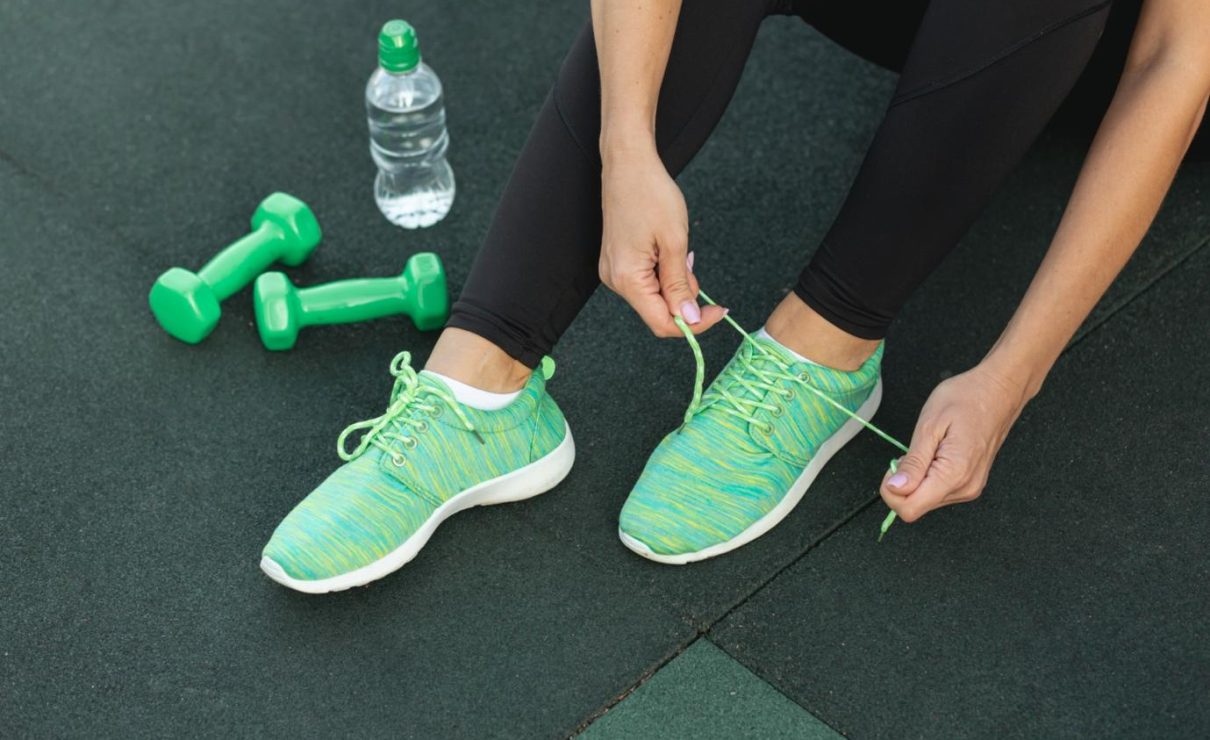What is the right kind of footwear for working out? Running? Exercising? People working out barefoot?
Introduction:
In the dynamic rhythm of our fitness journeys, the connection between our feet and the ground becomes a dance, shaping not only our strides but the very essence of our well-being. Our bodies, finely tuned instruments of health, are naturally attuned to the profound effects of going barefoot, a practice that transcends simplicity to offer potential health benefits. As fitness enthusiasts, we delve into the multifaceted dimensions of incorporating barefoot living into our daily routines, exploring its merits in everyday activities and deciphering the precautions when weaving it into our exercise regimens.
Barefoot walking emerges as a unique facet of our fitness narrative, a return to our primal connection with the earth beneath. The benefits it brings, though diverse, remain a personal journey, intricately shaped by our fitness routines, lifestyles, and individual preferences. As we navigate the realms of home workouts, outdoor runs, and gym sessions, understanding the nuanced advantages of barefoot engagement becomes pivotal in crafting a holistic approach to our fitness endeavours.
Yet, even as we embrace the simplicity of barefoot living, we are reminded of the indispensable role our footwear plays in our fitness odyssey. Footwear, far from being a mere shield, becomes an integral part of our fitness identity, influencing not only our performance but also reflecting the demands of our active lifestyles. From the weight room to the running trail, our choice of footwear becomes more than an accessory; it is a strategic partner, a necessity, and a silent storyteller of our fitness journey.
So, in this exploration of the intricate dance between barefoot simplicity and the artistry of footwear in the context of our fitness pursuits, we unravel layers that extend beyond the surface. Footwear becomes a language, each pair a silent communicator of our commitment to a healthy lifestyle. This journey is not just about what covers our feet during workouts; it’s a decoding of the language of fitness shoes, acknowledging their role as more than gear – they are an integral part of our fitness narrative, shaping our strides toward health and well-being. Even in the realm of sports and intense workouts, where precision is paramount, the choices we make in footwear can redefine outcomes and elevate our fitness experience.
So, let’s step into this intricate dance between the simplicity of barefoot fitness and the strategic choices in footwear, understanding that each step we take, whether bare or shod, contributes to our unique fitness story.
-
The Right Footwear for Exercise and Workouts
Understanding Your Foot Dynamics: The Foundation of Fitness
Choosing suitable footwear for exercise involves understanding the dynamics of foot movement. Each foot is as unique as its owner, with factors like arch support, pronation, and foot shape influencing the choice of shoes. Whether you’re hitting the gym, heading out for a run, or engaging in a high-intensity workout, recognizing these individual nuances is the cornerstone of a personalized approach. This goes beyond mere protection – it’s about supporting the intricate dance of muscles and joints as we move. Arch support becomes crucial, aligning with the natural contours of our feet and providing a foundation for a comfortable stride.
Exercise Essentials: Balancing Support and Flexibility
When it comes to general exercise and workouts, the ideal footwear strikes a delicate balance between support and flexibility. Cross-training shoes emerge as versatile companions, offering stability for weightlifting sessions and various movements while allowing the flexibility needed for dynamic exercises. These shoes become the reliable partner, adapting to the varied demands of a holistic fitness routine and that’s why understanding the demands of your exercise routine is key to selecting shoes that amplify your performance and prevent unnecessary strain.
Weightlifting Specifics:
Weightlifting demands specialized attention to footwear. The solid, elevated heel of weightlifting shoes becomes a critical feature, providing stability during squats and deadlifts. The flat sole establishes a solid base, ensuring proper form and reducing the risk of injury. In the realm of weights, the right shoes become the silent allies, ensuring a safe and effective lifting experience.
-
Choosing the Right Running Shoes
Consider Your Running Style:
Running is a unique dance with the ground, and the shoes become our partners in this rhythmic journey. The choice of running shoes should align with your running style, whether you’re a neutral runner, an overpronator, or a supinator. This alignment ensures optimal support, reducing the risk of injuries associated with improper footwear. The right shoes become the trusted companions, enhancing the fluidity of your run.
Shock Absorption and Cushioning:
The poetry of running involves a symphony of impacts – the repetitive percussion of feet meeting the ground. Running shoes become instruments, providing adequate shock absorption and cushioning. This harmonious interplay protects joints, ensuring the melody of your run remains smooth and comfortable.
Terrain Matters:
Running often takes us on diverse terrains, each with its own rhythm and demands. Trail running shoes become the explorers, offering enhanced grip and protection for off-road runs. On the other hand, road running shoes become the swift companions, prioritizing lightweight construction and cushioning for the urban runner. The right shoes adapt to the cadence of your run, ensuring every step feels like a seamless movement.
-
Tailoring Your Choice
The Art of Workout:
Workouts, with their diverse range of movements, demand specific considerations when it comes to footwear. Weightlifting, for instance, requires specialized shoes with a solid, elevated heel for stability during squats and deadlifts. The flat-soled design ensures a solid base, supporting proper form and minimizing injury risks. Tailoring your footwear to the demands of your chosen workout enhances both safety and performance.
Personalizing Fitness: Going Beyond the Norm
In the realm of fitness, personalization is not a luxury; it’s a necessity. Consider your unique fitness journey – existing foot conditions, fitness levels, and any specific requirements. Consulting with fitness professionals or healthcare experts can provide personalized insights, guiding you to make informed decisions that enhance your overall fitness experience.
Conclusion: Your Footwear, Your Fitness Journey
In the symphony of your fitness journey, your footwear plays a crucial role, and its selection goes beyond the ordinary. It’s about acknowledging the individuality of your feet, understanding the demands of each activity, and tailoring your choices accordingly. Personalization transforms your footwear from a mere accessory into a strategic ally, supporting your strides in exercise, running, and workouts. So, lace up those personalized kicks and step into a fitness journey that’s uniquely yours. This meticulous selection of footwear transforms exercise and running from mere physical activities into a choreography of comfort and support. The right shoes become extensions of our intent, allowing us to move confidently, whether lifting weights or traversing trails.
Now let’s look at the benefits and way for Barefoot training and overall experience in making it as part of lifestyle.
-
Everyday Barefoot Living: A Return to Natural Connection
Contact with Surfaces:
Naturally, walking barefoot engages a higher amount of surface area, promoting a biological understanding of our environment. This direct contact helps us balance our bodies and adjust our weight intuitively. From grass to sand, different surfaces offer unique sensory feedback, contributing to our overall well-being.
Medicinal Benefits:
Walking barefoot on natural surfaces, like grass, is often associated with medicinal benefits. Direct contact with the earth not only provides nutritional elements but also has a calming effect on the mind. Exploring the scientific nuances of this connection could reveal more hidden benefits.
-
Exercise and Barefoot: A Delicate Balance
Balancing Exercises:
In exercises that focus on balance, such as yoga, being barefoot is often recommended. The direct connection to the ground enhances proprioception and strengthens foot muscles. However, the choice to go barefoot during these activities depends on the cleanliness and evenness of the surface.
Exercise Intensity Matters:
For more intensive exercises like running, jumping, or heavy weightlifting, the dynamics change. The need for protective footwear arises to prevent injuries and provide support. Transitioning from a shoe-dependent exercise routine to barefoot activities should be a gradual process, considering the body’s adaptation to comfort.
Cushiony Footwear:
Our modern lifestyle has accustomed us to wearing shoes for extended periods. Therefore, sudden shifts to barefoot activities can put excessive pressure on the feet. Using cushioned footwear during heavy exercises helps strike a balance between protection and the benefits of going barefoot.
-
A Thoughtful Transition: Balancing Comfort and Health
Understanding Our Adaptations:
It’s essential to recognize that our bodies have adapted to certain comforts, including footwear. Abruptly abandoning these adaptations can lead to potential harm. Therefore, transitioning gradually from a shoed lifestyle to embracing barefoot moments requires careful consideration and examination.
Precautions for Exercise:
Before diving into barefoot exercises, individuals should carefully assess their fitness levels, any existing foot conditions, and their body’s response to the change. Consulting with a healthcare professional or a fitness expert can provide personalized guidance for a safe transition.
-
Striking a Harmony: The Middle Ground
Everyday Barefoot Moments:
Encouraging everyday barefoot moments, whether it’s a stroll on the grass or feeling the sand beneath your feet, can be a simple yet powerful practice. These moments contribute to a more profound connection with the environment and potential health benefits.
Balanced Exercise Routine:
Creating a balanced exercise routine that incorporates both barefoot activities and supportive footwear exercises ensures a holistic approach to fitness. This way, individuals can enjoy the benefits of barefoot living without compromising on safety or comfort.
Conclusion: Navigating the Barefoot Journey
In conclusion, embracing barefoot living is a journey that demands a nuanced understanding of our body’s adaptations and a thoughtful transition. From the everyday joys of walking on natural surfaces to the intricacies of exercise, finding the right balance is key. By recognizing the benefits and potential risks, individuals can navigate this journey with a focus on both comfort and health. Whether feeling the earth beneath our feet or opting for protective footwear during intense workouts, it’s about creating a harmonious relationship between our natural instincts and modern-day necessities.
Overall Conclusion with Final words: Harmonizing Your Fitness Path
As we navigate the intricate paths of exercise, running, and the potential joys of barefoot living, the essence emerges – personalization. Each step, whether adorned with specialized footwear or connecting directly with the earth, contributes to a harmonious fitness journey. It’s about crafting an experience uniquely tailored to your body’s dynamics, acknowledging the benefits, and navigating potential risks with informed choices. In this symphony of personalization, from the nuanced selection of exercise shoes to the considerations of embracing barefoot moments, each choice becomes a testament to your commitment to well-being. So, stride confidently, whether shod or barefoot, and let your fitness journey be a reflection of your individuality and dedication to a healthier, balanced life.



